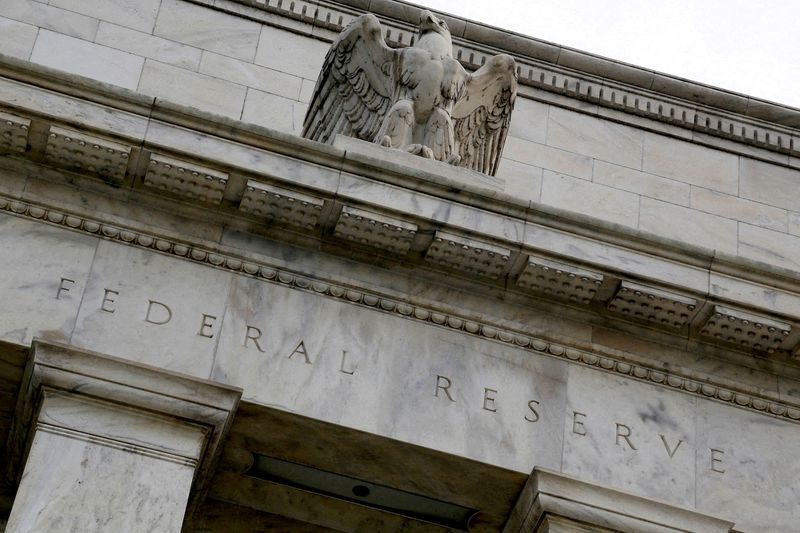Column-Trapdoor for dollar, red flag for Fed: Mike Dolan By Reuters

© Reuters. FILE PHOTO: An eagle tops the U.S. Federal Reserve building’s facade in Washington, July 31, 2013. REUTERS/Jonathan Ernst/File Photo
2/2
By Mike Dolan
LONDON (Reuters) – The U.S. dollar’s accelerating decline from the heady highs of 2022 has a ways to go yet – but the speed of the drop may build a case for a soft landing of its own later this year.
A reversal of the near 30% jump in the dollar’s main index, from the post-pandemic lows of early 2021 to September’s 20-year peak, always seemed a sure bet once markets spied the peak of Federal Reserve interest rates on the horizon.
As it stands, a frantic Fed tightening campaign that supercharged the buck looks to be nearing an end amid evidence of steady disinflation. Futures see a couple more modest rate hikes and a ‘terminal rate’ somewhere just under 5% by midyear, followed by about a half point of cuts in the second half.
Taken in isolation, that would appears to have lopped more than 10% off the buck over the past three months.
But it’s been much more than a Fed story. The stars are aligning against the dollar around the world.
Japan’s dramatic currency intervention in October stabilised the then-plummeting yen but it culminated last month with the Bank of Japan’s first gradual move away from its ultra-loose monetary policy. Braced for further tightening, the yen has now recovered almost 20% in little over two months and December’s policy shift is unlikely to be a one-off.
As the European Central Bank turned more hawkish late last year in the face of double-digit euro zone inflation prints, the euro also rebounded sharply. It’s accelerated since to clock 3-month gains of about 14% as a peculiarly warm winter and high storage halved the sky-high European gas prices that many had bet would seed recession, leading some to rethink the downturn as outages and rationing look to have been dodged.
And after unprecedented popular protests, China suddenly abandoned its draconian and economically damaging ‘zero COVID’ policy last month – with the prospect of a sharp rebound in Chinese demand this year lifting the yuan some 10% from last year’s lows already.
Even though consensus forecasts at the start of the year seemed cautious about the extent of further moves, the constellation of recent events is forcing many global banks to reconsider their dollar views for the year.
Just this week, Morgan Stanley (NYSE:)’s team said they would “double down” on their dollar bearishness and cut forecasts further – seeing DXY 6% lower than previously and euro/dollar as high as 1.15 versus 1.08 before that.
“Macro forces once constraining dollar weakness are now amplifying it,” they said. “Global growth is showing signs of buoyancy, macro and inflation uncertainty are waning, and the dollar is rapidly losing its carry advantage.”
HSBC also sees the euro adding another 6% this year and last week cut its yearend dollar/yen forecast to 120 from 130 previously. “The dollar’s correction lower…
Read More: Column-Trapdoor for dollar, red flag for Fed: Mike Dolan By Reuters
